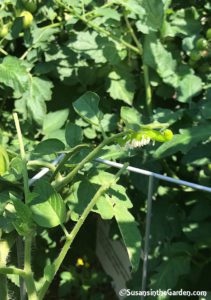Hornworms, Tomato
 Latin name: Manduca quinquemaculata
Latin name: Manduca quinquemaculata
Size: Up to 4″ long!
Color: Green with white stripes and black dots, with a pseudo “stinger” on its hind end
Life cycle: After emerging in the spring, the adult moths (known as Hawk or Sphinx moths) mate. The females lay very pale green eggs lay on both sides of the leaves of Nightshade-family plants. The caterpillars hatch and grow as they feed, then drop off the plant in the fall to pupate in the soil.
Signs of their activity: Chewed leaves, nibbled tomatoes, dark brown droppings on ground beneath the damage.
Typically seen on: Members of the nightshade only (tomatoes, peppers, eggplants, potatoes or nightshade weed) but primarily on tomato plants.
Controls: Monitor your plants for damage on a regular basis as the caterpillars blend in really well with the foliage. Remove them through hand-picking. Spray with Bt when caterpillars are present. Also consider interplanting parsley, dill, basil or marigolds with your tomato plants as a natural repellent.
Natural predators: Ladybugs and lacewings prey on the eggs and young caterpillars. Paper wasps eat the caterpillars as well. The parasitic Braconid wasp (Cotesia congregatus) lay eggs on the caterpillars, from which larvae hatch and feed on their host. If you see a hornworm with what looks like white eggs on its body (see photo above, click on it to view a larger image), leave it be: nature is resolving your problem!
Additional information: University of Minnesota Extension Tomato Hornworms in Home Gardens and Colorado State University Extension Hornworms and ‘Hummingbird’ Moths.
Back to Organic Pest Control
